| Uncle Al's 2017-2020
Racing Rules
in Pics Rules are quoted, then illustrated and explained as seems necessary.
for instant access without scrolling, click on the Rules listed below 10 On Opposite Tacks 11 On the Same Tack, Overlapped 12 On the Same Tack, Not Overlapped 13 While Tacking ... |
||
| 10 On Opposite
Tacks When boats are on opposite tacks, a port-tack boat shall keep clear of a starboard-tack boat. |
||
 |
||
|
This is the classic
port-starboard situation: Upwind, Peter Rahn (W286) is
on port tack since Shadow's
windward
side is her port side. Shadow is approaching Free
Range Chickin' (Richard Johnson, yellow hull) who
is on starboard tack (her windward side being her
starboard side). Peter will have to keep clear
of Richard.
... |
||
 |
||
|
Harder to figure out is
this situation where Jacob Knudsen (beige hull) and
Jørgen Vekslund (white hull on right) are not only on
widely different points of sail but also on opposite
tacks. Jacob is on port tack and will have to keep clear
of Jørgen. No "close-hauled over running free"
like they used to say when Uncle Al started racing in
the 1950's.
... |
||
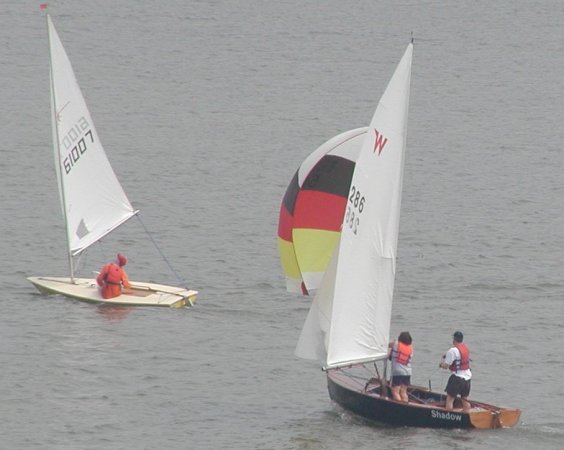 |
||
|
No "overtaking boat,
keep clear" here, either!! Why not? Because rule 12 only applies
to boats that are on the same tack!! Here Peter
(W286) is on starboard so that Brad Biskaborn (Laser
61007) who is on port, will have to make sure that he keeps
clear. Of course, a quick gybe by Brad would make
Peter an overtaking boat who does have to keep
clear.
... |
||
| 11 On the Same
Tack, Overlapped When boats are on the same tack and overlapped, a windward boat shall keep clear of a leeward boat. |
||
 |
||
| The classic situation: Uncle Al (3854) is
to windward and must keep clear of Heider Funck (W6). ... |
||
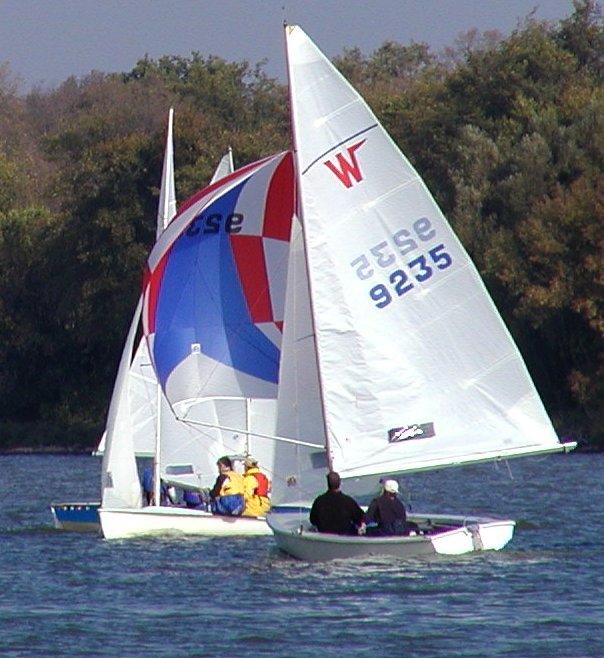 |
||
|
Less obvious is this
situation where Brian Jeffs (W9235) is on the same tack
as the white-hulled 420 off his bow. Since Brian is off
the 420's windward side, he - as the windward boat -
must keep clear of the 420. If I am on a collision
course with a boat on the same tack as I am, I use the
"close-hauled over running free" adage to remind me that
the running boat will always be to windward and will
have to keep clear. Of course, if Brian (9235) were to
gybe, the boats would no longer be on the same tack and
Brian would have the right of way under Rule 10. But then, if Brian did
that, the blue-hulled Snipe behind the 420 would
be leeward and Brian would have to keep clear of her.
... |
||
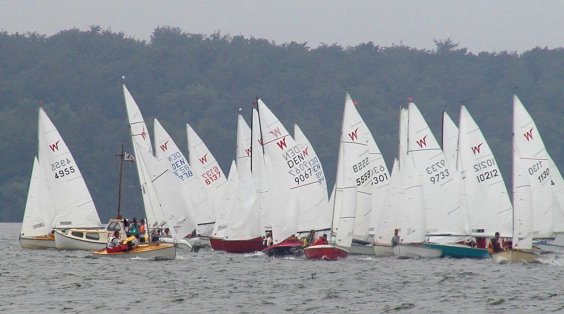 |
||
|
Except for the
occasional sailor with a death wish, every big fleet
start like this one in the Wayfarer DM (Nationals) in
Farum, Denmark, is a mass of starboard boats in
windward-leeward situations since Rule 18 (mark- room)
does not apply at a starting mark.
... |
||
| 12 On the Same Tack, Not
Overlapped When boats are on the same tack and not overlapped, a boat clear astern shall keep clear of a boat clear ahead. |
||
 |
||
|
The Taylor brothers,
Mark and Paul, (W7673) are - surprise! surprise! - not
permitted to "rear end" John Cawthorne in W3654 who is
on the same tack and clear ahead.
... |
||
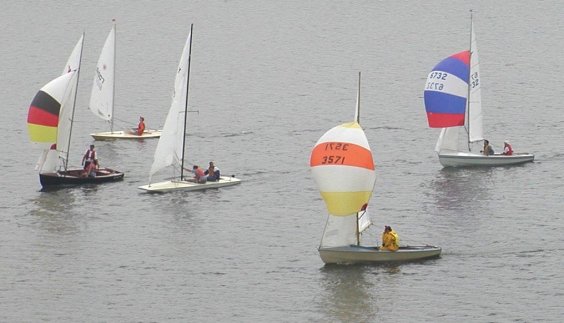 |
||
|
The four boats on the
left are all overlapped but Len (W6732) is clear astern
and must keep clear as he closes in while bringing a
puff from astern.
... |
||
|
After a boat passes head to wind, she shall keep clear of other boats until she is on a close-hauled course. During that time rules 10, 11 and 12 do not apply. If two boats are subject to this rule at the same time, the one on the other’s port side or the one astern shall keep clear. |
||
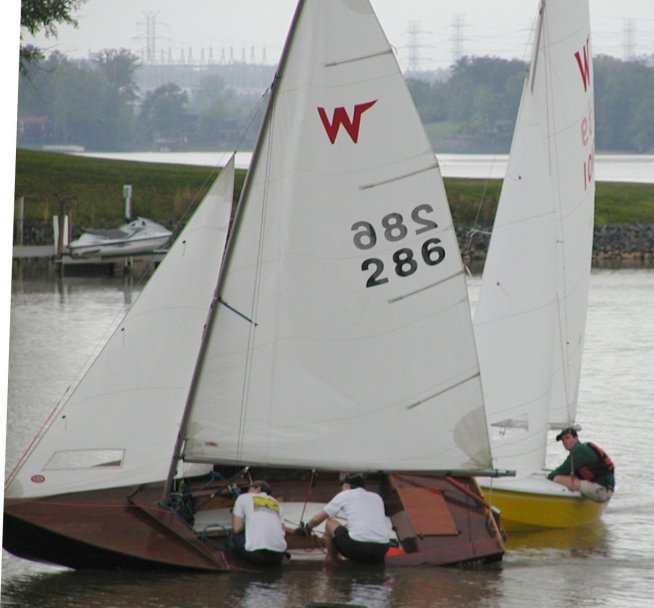 |
||
|
Peter (W286) is just
past head to wind but not yet on a close-hauled course.
He is therefore in the process of tacking and
must keep clear of Richard (yellow hull) until he
(Peter) completes his 90º turn.
... |
||
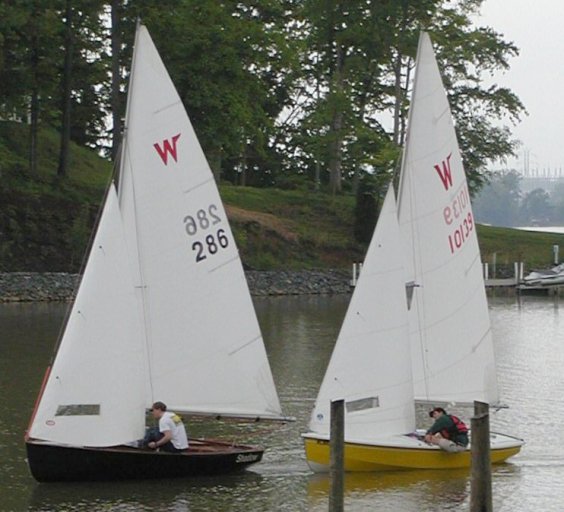 |
||
| Here Peter's tack is complete and Rules 10, 11 and 12 begin to apply
to both boats once more. .. |
||
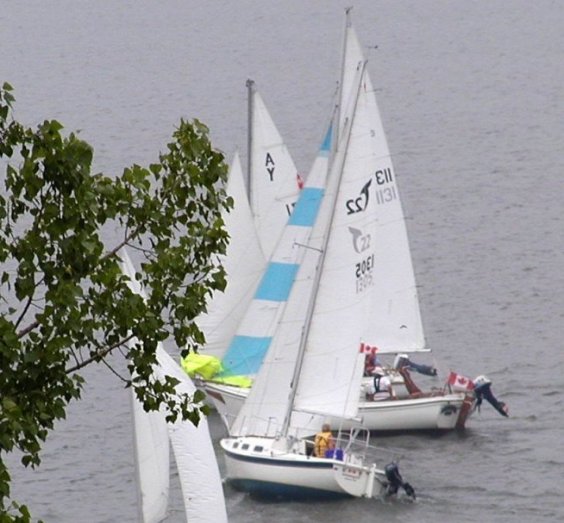 |
||
|
I have used a mirror
image of the original photo here to create a more
realistic situation in which the middle boat might have
just put his helm down to initiate a tack. It is crucial
to understand that even when a leeward boat has yelled
"TACK" to his crew and put the tiller hard over, he
remains leeward boat with rights over windward (the
Tanzer 22 closest to the camera) under Rule 11 until he passes
head to wind - and windward must keep clear accordingly.
... |
||
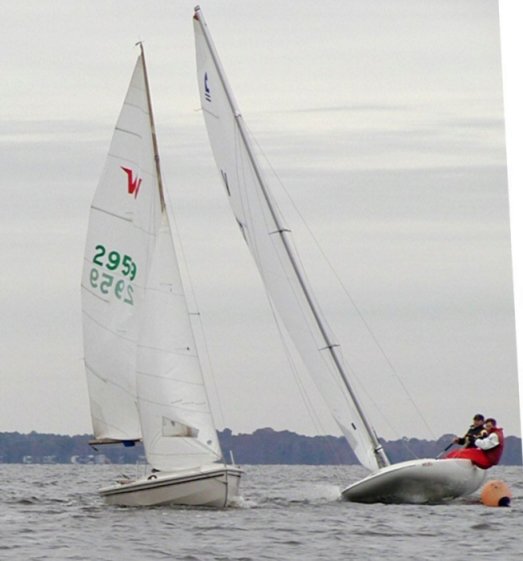 |
||
|
Likewise, Butch Minson
in W2959 has not yet reached the head to wind position
and has therefore not officially begun to tack even
though his tiller is already hard over. Until Butch does
begin to tack, the C Scow must keep clear under Rule 11.
... |
||
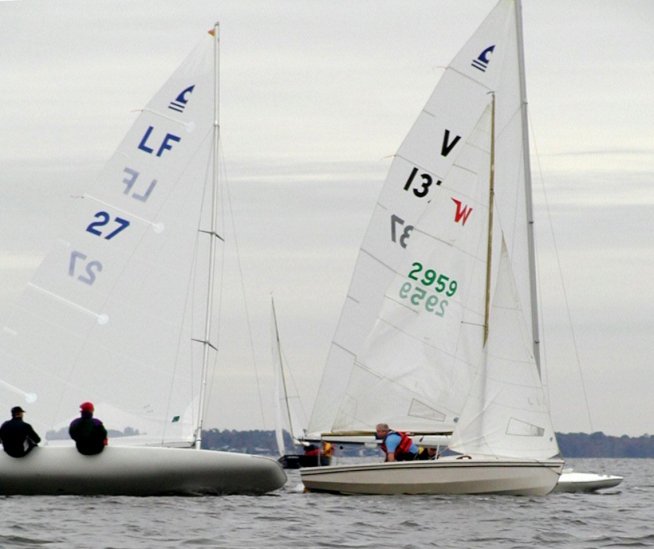 |
||
|
A couple of seconds
later, Butch is in the middle of a slow tack. This
situation could have been a real mess as all three boats
are just finishing (see mark in previous photo). If LF27
weren't barrelling in on starboard, Butch (2959) would
not have rights to tack into V137's way - in fact, he
probably had no real right to tack here: Given the
presence of the starboard boat, Butch was presumably
entitled to call for room to tack for the obstruction
(LF27) under Rule 19
but would have had to do so well earlier than this and
then would have had to miss the finish line by tacking.
What a potential mess!!! In the end, Butch was pretty
safe to do what he did, anticipating that V137 would
tack right around the mark to take a photo finish ahead
of LF27. As you can see above, V137's tack came just
barely in time for Butch - those C Scows are big,
heavy boats!!
...
|
||
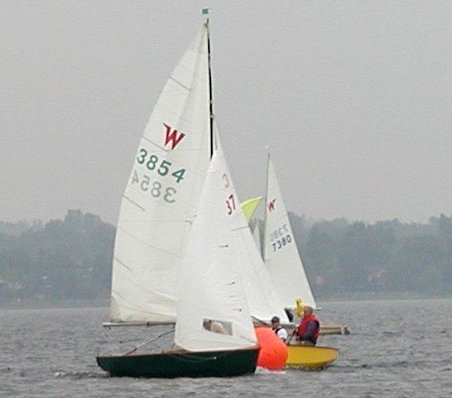 |
||
| Above, Uncle Al (3854) has just luffed up
to cross the finish line faster. Even rounding a mark,
rule 13 applies. If this were
not the finish, and Al were preparing for another
downwind leg, he might have to luff beside the mark
until Bill Fyfe (yellow hull) was sailing past 3854’s
transom. Only then would he be safe to actually tack
without risk of fouling Bill.
... |
||
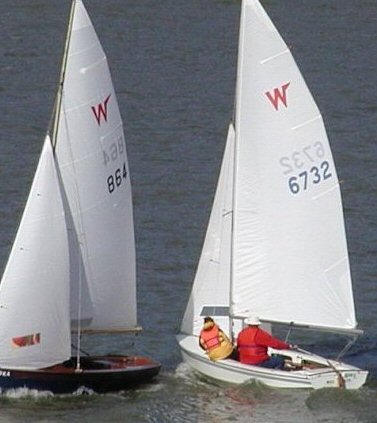 |
||
| The second
sentence of rule 13 (which
deals with two boats tacking at the same time) rarely
applies and in my experience usually arises from the
situation above. Pretend W2960 is not in this picture and
that Nick (W864) is not quite laying the finish line on
starboard tack. Nick (W864) now wants to tack to port -
which will also effectively pin Len (W6732) on port tack
until Nick is ready to let him tack for the line. Len has
the same idea: if he tacks right now, he can pin Nick on
starboard until both have overlaid the line, and Len is
ready to make a dash for it. If both boats then tacked at
the same time, Nick would have to keep clear since he
would be on Len's port side. I did this once in a stiff hiking breeze at the 1980 Wayfarer Worlds with spectacular results: Having borne away to a planing reach, I floored SHADES across the other boat's transom with an inch or two to spare, shoved the tiller over and screamed "Tacking to starboard!!" but the other boat (in Nick's position) was now also tacking (as I had expected). What I had not expected however, was that he just kept turning and tried to bear away behind me. He came to a crunching stop inside my forward buoyancy compartment. Would I do it again, 36 years older and wiser? Absolutely!!! It's a great tactical move and one worth adding to your arsenal!! ... |
|
Rules
in
Pictures index
DefinitionsPart 2A Part 2B Part 2C Part 2D + penalty turns Photo-based Rules Quiz - 1 Photo-based Rules Quiz - 2 |